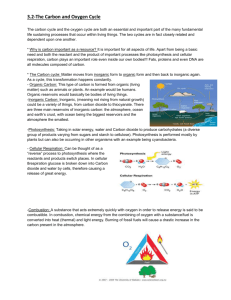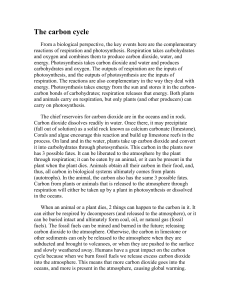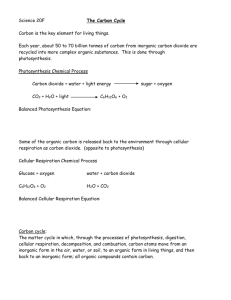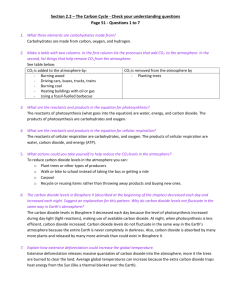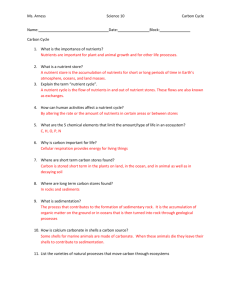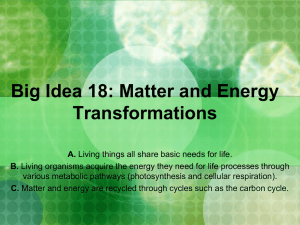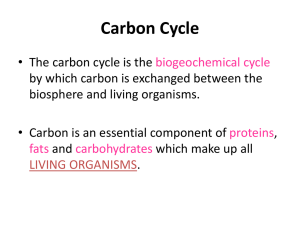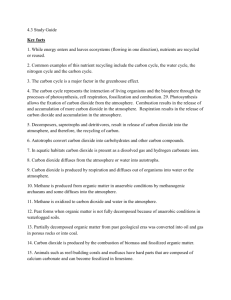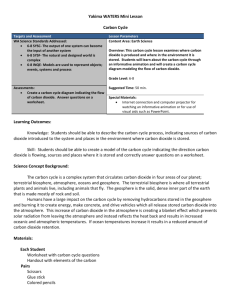Carbon cycle: where is this crucial carbon? (teacher`s notes)
advertisement
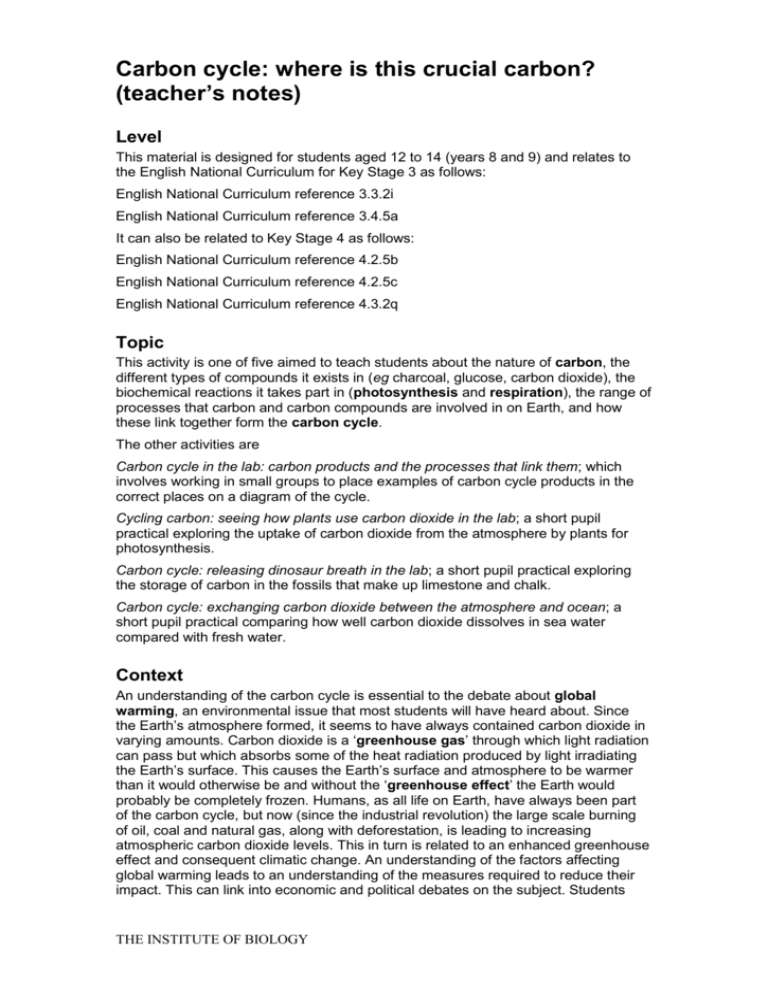
Carbon cycle: where is this crucial carbon? (teacher’s notes) Level This material is designed for students aged 12 to 14 (years 8 and 9) and relates to the English National Curriculum for Key Stage 3 as follows: English National Curriculum reference 3.3.2i English National Curriculum reference 3.4.5a It can also be related to Key Stage 4 as follows: English National Curriculum reference 4.2.5b English National Curriculum reference 4.2.5c English National Curriculum reference 4.3.2q Topic This activity is one of five aimed to teach students about the nature of carbon, the different types of compounds it exists in (eg charcoal, glucose, carbon dioxide), the biochemical reactions it takes part in (photosynthesis and respiration), the range of processes that carbon and carbon compounds are involved in on Earth, and how these link together form the carbon cycle. The other activities are Carbon cycle in the lab: carbon products and the processes that link them; which involves working in small groups to place examples of carbon cycle products in the correct places on a diagram of the cycle. Cycling carbon: seeing how plants use carbon dioxide in the lab; a short pupil practical exploring the uptake of carbon dioxide from the atmosphere by plants for photosynthesis. Carbon cycle: releasing dinosaur breath in the lab; a short pupil practical exploring the storage of carbon in the fossils that make up limestone and chalk. Carbon cycle: exchanging carbon dioxide between the atmosphere and ocean; a short pupil practical comparing how well carbon dioxide dissolves in sea water compared with fresh water. Context An understanding of the carbon cycle is essential to the debate about global warming, an environmental issue that most students will have heard about. Since the Earth’s atmosphere formed, it seems to have always contained carbon dioxide in varying amounts. Carbon dioxide is a ‘greenhouse gas’ through which light radiation can pass but which absorbs some of the heat radiation produced by light irradiating the Earth’s surface. This causes the Earth’s surface and atmosphere to be warmer than it would otherwise be and without the ‘greenhouse effect’ the Earth would probably be completely frozen. Humans, as all life on Earth, have always been part of the carbon cycle, but now (since the industrial revolution) the large scale burning of oil, coal and natural gas, along with deforestation, is leading to increasing atmospheric carbon dioxide levels. This in turn is related to an enhanced greenhouse effect and consequent climatic change. An understanding of the factors affecting global warming leads to an understanding of the measures required to reduce their impact. This can link into economic and political debates on the subject. Students THE INSTITUTE OF BIOLOGY should have already covered photosynthesis and respiration in order to do this activity effectively. Teaching points Carbon is the fundamental building block of life (the element that life is based on). It is contained by everything from fossil fuels to DNA. Despite being very important, carbon, is in fact not the most abundant element on Earth. (The prize for abundance goes to silicon that is, interestingly, similar to carbon in atomic structure and some key chemical properties). Carbon is cycled and re-cycled through the carbon cycle. Both animals and plants need it although they obtain it in different ways. It is worth revising respiration and photosynthesis with students. Ensure that they understand that the charcoal produced in the demonstration is not the form in which it exists in the body and that it is just a demonstration of the presence of carbon in food and other materials. Apparatus and materials The teacher will need: Eye protection Bunsen burner Safety screen Tongs Tray of sand Whiteboard or A2 white paper Lump of coal Bacon, sausage White bread, crisps, cereal Dead twig (not green) Artist’s charcoal Safety The teacher will burn objects over a Bunsen flame to carbonise them and should wear eye protection. Pupils should be a suitable distance away, perhaps behind a safety screen, in case the objects spit as they burn. Activity Starting point: What is the connection between you and a lump of coal? Main activity: Teacher-led discussion. As it proceeds and pupils provide answers to questions a record is kept of their answers on the whiteboard. Suggested sequence of questions and demonstrations: Q 1. What do living things need in order to grow? = Food (Revision of living processes) Q 2. Where do plants get their food from? = They make their own from carbon dioxide (CO2) (in the air/atmosphere) and water (H2O), using energy from the sun. The food they produce is in the form of sugars and starch (carbohydrate). (Revision of photosynthesis). Q 3. At this stage the teacher holds the twig over the flames until it is suitably black. Do the same with the cereal, potato crisp and bread (ensuring that the THE INSTITUTE OF BIOLOGY pupils remember that these are made of plant matter!). For each, the teacher asks what is left after burning. = Carbon. Teacher (or pupil) writes this in on the record, using the burned objects themselves or possibly, the artist’s charcoal. Q 4. Where do animals get their food from? = Eating plants and/or eating animals that have eaten plants. (Revision of respiration and energy production). Q 5. At this stage, the teacher burns the bit of bacon (or sausage) until it is suitably black. Teacher asks what is left? = Carbon. Write this on the record. Q 6. What happens to food in the body? = Digested, absorbed, incorporated, used up. Revise respiration as a process used in cells to release energy from food by reacting with oxygen, then carbon dioxide is exhaled as a by-product. This reaction is somewhat akin to the burning just viewed but much more controlled. It is worth discussing what burning actually is – where does all the stuff that is not carbon go? What gases are released? Why are you left with just carbon when you hold a piece of plant or animal matter in a flame? Compare this with the reactions that constitute respiration. Q 7. Review the record and ask: Where did the carbon in all these objects come from originally? = Atmosphere. Q 8. What happens to carbon? = Incorporated into living things, passes along food chain, some breathed out by animals and returns to the atmosphere, some “locked up” in animals and plants until they die and decompose, some locked up for an very long time when plans and animals are fossilised and forms rocks like coal and also the widespread calcium carbonate-rich rock, limestone. Points to bring out It could be mentioned that pupils themselves are carbon recyclers! However, teachers beware that this might involve discussion about burial versus cremation! THE INSTITUTE OF BIOLOGY

